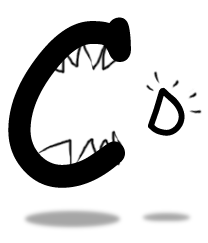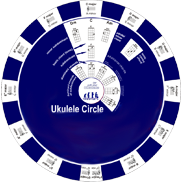Tunings
 C eats D... C eats D...
For the English
speaking part of the world the soprano-tuning G-C-E-A seems to be the standard tuning, called Hawaiian tuning. It actually is used nowadays both, for soprano and
tenor ukuleles, and concert ukuleles as well. As far as I could find out there is evidence that Hawaiian soprano ukuleles have been tuned A-D-F#-B as well, still popular in some parts of Canada and Europe, as for Germany due to the fact that several German manufacturers early started to copy first Hawaiian instruments - for more info on this you could proceed to > History.
The traditional soprano tuning is A-D-F#-B still was common back at the beginning of the 20th Century, when Hawaiian music became popular in the United States, indicated in many songbooks and chord tables of that time. At VintageUke.com there are a few examples of the D-tuning. In old ukulele songbooks you can find as well various changes of disposition to the preferred modes and complex harmonic sequences of the early jazz era. Historical songbooks therefore show along with the D6-tuning on flat keys adapted fingerings to be able to acocompany in keys such as F, B, Eb or Ab. One of the most famous ukulele players of that time preferred these down-tunings, Cliff Edwards, alias Ukulele Ike.
The discusion on the C6 vs D6 tuning is mentioned at ukuleleyes.com.
|
Sopranino-Ukuleles are small sopran-ukuleles and tuned like that, but it appears to be more a fun thing than a really playable instrument.
Bariton-Ukuleles are tuned like the four highest strings of a guitar (D-G-H-E). That is why it sounds more or less like a guitar, in fact the only ukulele which could called a little guitar.
Bass-Ukuleles are tuned like the low strings of a guitar: E-A-D-G. Actually there is none that would really have an acoustic sound like bass, it can be simulated only with electronic devices.
Tenor- and Concert-Ukuleles are tuned in C6, as metined above.
 A so-called Guitar-Ukulele is similar in shape to a "stretched" ukulele, but are tuned like guitars. The models offered by the Chinese manufacturer Mahalo - inferior, but very colorful - are currently offered by some dealers. The so-called Guitalele is mentioned as a hybrid from guitar and ukulele, but is in fact just a small guitar, tuned a fourth higher than standard guitars, to my knowledge only made by Yamaha, in Indonesia. A so-called Guitar-Ukulele is similar in shape to a "stretched" ukulele, but are tuned like guitars. The models offered by the Chinese manufacturer Mahalo - inferior, but very colorful - are currently offered by some dealers. The so-called Guitalele is mentioned as a hybrid from guitar and ukulele, but is in fact just a small guitar, tuned a fourth higher than standard guitars, to my knowledge only made by Yamaha, in Indonesia.
There are more different tunings, used for instance on the Polynesian and Melanesian islands, and tunings for 6- and 8-string ukuleles (which you can find on the end of this page).
 Tuning can be
a work of filigree in the beginning because of the short strings and because
of primitive mecanics. However, when tuned once, a ukulele can keep the tuning
for a long time, as far as you do not take it outside.
The tuning fork is preferable for anyone who has a trained ear. Caution! In addition to inferior instruments there are more and more tuning forks from China in the trade. They're cheaper, butyou can not be sure if it is on the exact pitch of A - 440 Hz. The audible differences vary by tenths and are completely unacceptable. Tuning can be
a work of filigree in the beginning because of the short strings and because
of primitive mecanics. However, when tuned once, a ukulele can keep the tuning
for a long time, as far as you do not take it outside.
The tuning fork is preferable for anyone who has a trained ear. Caution! In addition to inferior instruments there are more and more tuning forks from China in the trade. They're cheaper, butyou can not be sure if it is on the exact pitch of A - 440 Hz. The audible differences vary by tenths and are completely unacceptable.
Electronic tuners can be helpful for beginners. Even with these devices, there are differences in quality ... And just an electronically measured frequency of each string does not mean that the tuning is also right "in itself"!
A small screwdriver always belongs into the bag ore case, because sometimes you have to fix the vortex. If it is too loose, it slips back under the string tension, for example during a long transport, so they are after shipping in general.
New strings should be prepared one or better two weeks before playing in public, because they need a little adjustment over and over again. If your ukulele does not suffer from large temperature fluctuations, you won't need much adjustment over time. Of course there are strings of different quality. Carbon strings are often praised, but it also depends on the quality of your ukulele. I use simple nylon strings of the manufacturer and have good experiences there, so I consider myself better get out of shop talk.
|



